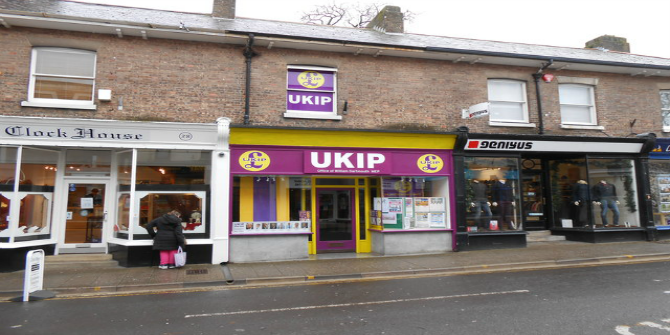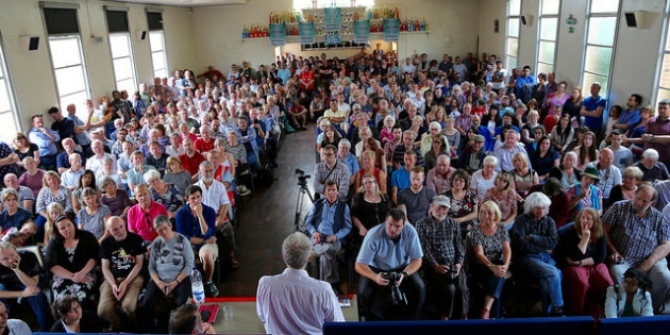Drawing on newly released files available at The UK National Archives, George Kassimeris and Oliver Price assesses how, between the late 1970s and early 1980s, Militant became the first and only Trotskyist group to be considered by MI5 a significant subversive threat to British internal security.
For much of the twentieth century, one of the primary concerns of Britain’s Security Service (MI5) was subversion – ‘activities threatening the safety or well-being of the State and intended to undermine or overthrow Parliamentary democracy by political, industrial or violent means.’ The major targets of MI5’s counter-subversive operations until the 1970s were Communists and the Communist Party of Great Britain (CPGB), which was subjected to sustained and extensive surveillance following its formation in 1920. The Trotskyist movement, which emerged in Britain during the early 1930s, was regarded by MI5 as being ‘too small and chaotic’ to be capable of posing any significant subversive threat to the British state.
The activities of Militant Tendency (MT), a Trotskyist organisation which came to prominence as a result of its infiltration of the Labour Party in the 1970s and 1980s, transformed intelligence officers’ perception of Trotskyists. By the early 1980s, Militant was believed to be capable of posing an equal, if not greater, subversive threat than the CPGB. By 1984, one Whitehall official declared in a memorandum sent to MI5 that ‘Militant seems to have replaced the Communist Party as the established focus for subversion within the country’.
Militant was considered to pose such a threat because a significant number of its members had managed to infiltrate the Labour Party; they aimed to transform it, from within, into a ‘revolutionary party.’ This became possible after the left-wing National Executive Committee of the Labour Party decided, in 1973, to abolish its List of Proscribed Organisations which had long been crucial in preventing elements of the far left gaining influence within the Party. MI5 subsequently began an extensive investigation of Militant’s activity, and in 1976 reported that Trotskyists had influence in over 70 Constituency Labour Parties (CLPs); in nine they posed a threat to the sitting Labour MP. This information was passed on to the Labour Home Secretary, Merlyn Rees, who, according to MI5’s Director General Michael Hanley, ‘fully seized the importance of subversive penetration of the Labour Party’.
Intelligence officers had some difficulty investigating Militant as the organisation was highly secretive. Attendance at its meetings was strictly controlled and the annual Militant conference was closed to the public; any documents handed out at the conference were numbered and collected in at the end of each session. Despite this, the intelligence agencies did manage to infiltrate meetings and, in particular, the annual conference. In a 2002 documentary, former Special Branch officer, Tony Robinson, recalled hiding in a ‘cubby hole’ in the conference hall to record the meeting. At the conference in 1977, Peter Taaffe, deputy leader of Militant, was recorded, by intelligence operatives, stating that the movement would be ‘an indispensable weapon of the Revolution in Britain.’ MI5 investigations into Militant were eventually highly successful. By the late 1970s, MI5 had identified about 75% of the Tendency’s membership through a combination of telephone checks, agent penetration, informants, and eavesdropping on annual conferences. These successes came with one caveat: MI5 never felt it had absolute knowledge of Militant and stated in one report that ‘there were a number of limitations in the intelligence available on MT which was a clandestine organisation’.
Militant’s infiltration of the Labour Party allowed it to achieve several successes during the 1980s. It had significant influence on the Labour-led Liverpool City Council and the Council’s Deputy Leader, Derek Hatton, a Militant member, became a household name. Three Militant members were also elected as Labour MPs – Dave Nellist and Terry Fields at the 1983 General Election, and Pat Wall in 1987. It is unclear how extensively Militant members in Liverpool were monitored. Although no files have been released, a former Special Branch officer admitted in 2002 that a file was held on Hatton. There is little more known about the monitoring of the Militant MPs. Merseyside Police in 2008 confirmed ‘they had collected some material’ on Fields ‘for the purpose of investigations’, whilst a former Special Branch officer admitted to the BBC that MI5 had asked the West Midlands branch to find an agent to infiltrate the Coventry Labour Party to monitor Nellist whilst he was a sitting MP. The agent was instructed to ‘cultivate’ Nellist, and developed a close relationship with him, ‘helping him with a lot of things’ and ‘going around with him to a lot of meetings.’ The unnamed former Special Branch officer justified the surveillance by arguing that MI5 were not monitoring any specific individuals and instead monitoring Militant. Reports were produced on Nellist, the officer stated, because ‘he was at a [Militant] meeting.’
In the mid-1980s, the authorities also expressed concern about Militant activists’ influence in Civil Service unions. They were believed to have played a part in a 1984 strike at the offices of the Department of Health and Social Security which severely disrupted pension and child benefit payments to millions of people. Whitehall officials believed that Militant activists were keen for the strike to go on indefinitely because of the disruption it would cause to government services. In 1985, the Cabinet Secretary, Sir Robert Armstrong, wrote that Militant’s activities represented a ‘new and disturbing form of subversion’; unlike Communists, Militant members did not threaten the security of secret information, but instead threatened to disrupt the effective operation of government.
A subsequent Whitehall investigation found that Militant members were ‘active and adept at exploiting real or imagined grievances amongst [Civil Service] staff.’ They were considered a greater threat than other Trotskyists in the Civil Service due to their organisational capabilities and their stronghold in some Civil Service unions, particularly the CPSA. All government departments were subsequently required to work with MI5 to produce an up-to-date list of subversives working within the Civil Service. Each department was advised to develop procedures to ensure ‘subversives are not posted to work in Key Areas’ and ‘persistent troublemakers, whether members of subversive organisations or not, are identified and removed from work in Key Areas’. Signing off the new policies in December 1985, Margaret Thatcher made clear her belief that Civil Service management should ‘be very ready to sack subversive troublemakers if they showed any cause under the Civil Service rules.’ It is unclear how many, if any, Militant members working in the Civil Service were consequently transferred to other posts or even dismissed.
Although Militant’s activities greatly concerned both intelligence and Whitehall officials during the 1970s and 1980s, its ability to pose a significant subversive threat was short-lived. The Labour Party began to recognise the threat Militant posed and by the mid-1980s had reintroduced proscription and begun to expel some Militant members. This, in turn, led the authorities to believe that once Militant’s power base was removed, and its tactics exposed, it would have ‘no immediate springboard for disruptive activity’. By 1987 Whitehall officials were sufficiently sanguine to state that any future action should be proportionate to what was a limited threat.
Militant had been able to develop and gain significant influence in the Labour Party due to a combination of the Party’s lax disciplinary procedures and of the unity, dedication, and discipline of Militant members. The growth of Militant in the Labour Party in the mid-to-late-1970s led MI5 to carry out extensive investigations. Yet could Militant have really posed a significant threat to the British state, and did Security Service action prevent it from doing so? As the intelligence historian Christopher Andrew once said, ‘the success of the security services’ operations is best judged by things that do not happen.’ The height of Militant’s power and influence may have been short-lived, but the extent to which the Security Service investigated it indicates that its ability to threaten the British state may have been more significant than possibly previously recognised. During the late 1970s and early 1980s, Militant was the first and only Trotskyist organisation that fitted MI5’s definition of subversion and was believed to pose a genuine threat to security.
___________________
Note: The above draws on the authors’ published work in Contemporary British History.
George Kassimeris is Professor of Security Studies at the University of Wolverhampton.
Oliver Price is a PhD candidate at the University of Wolverhampton.
Featured image credit: Wikimedia Commons licensed under the Creative Commons Attribution-Share Alike 2.0 Generic licence.







